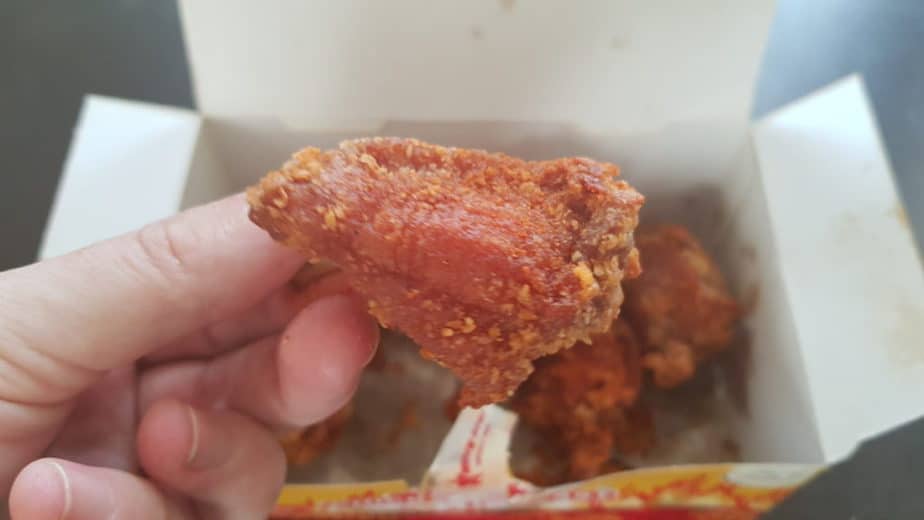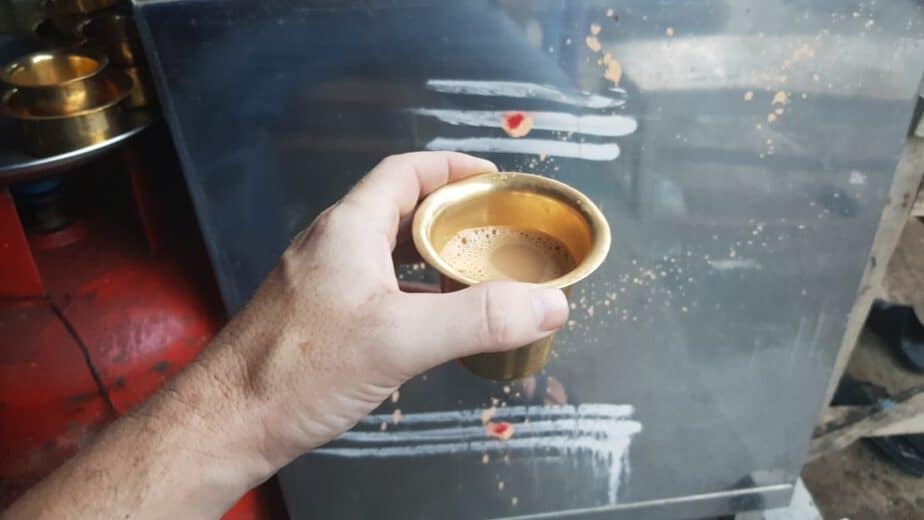I’ve been in India for over 7 months and I’m happy to say that I’ve never been really sick. Here’s what I’ve learned about how to stay healthy while living and traveling in India…
Is it safe to eat bananas in India? Yes, bananas are one of the safest foods to buy off the street because they are covered in a peel. To be extra safe, you would want to peel the banana with one hand and only touch the edible part with your other clean hand.
It requires some dexterity on your part but I’ve found it’s pretty easy to do now and peel all my bananas with just one hand. I also used to eat my bananas the typical way and I never got sick. Since I’ll be in India for months or maybe even years, I do want to minimize my risk of getting sick though, which is why I’ve made this change. There may be contaminants or pesticides on the outer peel of the banana.
WARNING: This post is a bit of a downer because it tells you all the stuff to watch out for and what NOT to eat. You will see many delicious foods on the street and you’ll want to eat them. If you’re okay with risking it, go for it. This article is just to make you aware of the risks. I didn’t know a lot of this stuff before I came, so it may help you stay sick. It’s up to you though how picky you get!
Here are the full details about this tip and 13 others to avoid getting sick in India…
1. Peeling Your Banana with One Hand
Here’s the entire process in minute detail:
- Before peeling a banana, I will use hand sanitizer on both hands.
- I take a banana with my ‘peeling’ hand, and I will set it on a clean plate on my counter.
- Using the peeling hand I will start peeling the banana.
- As soon as I expose some of the inner fruit, I will use my eating hand to grip the banana but only touching the inner fruit.
- With my peeling hand, I will continue to remove the peel until the fruit is completely exposed.
If the banana is difficult to get started, I will use a knife and make a small cut at the top.
In this way, I only use my clean hand to eat the banana. It’s a bit nitpicky but as the saying goes, better to be safe than sorry. 🤓
You would also want to do the same within oranges, they are even more difficult. I will use a knife to make a cut then with one hand start peeling it. I will hold the orange with a paper napkin with my other hand.
2. Don’t Drink The Water, Especially…
The water here should be avoided at all times.
This is the most obvious advice, that I’m sure you already know. There may be some aspects of this that you may NOT know:
- Bring your own napkins so you can wipe down your plate if you’re getting food in a local restaurant. If you’re in a nice hotel or Western-ized restaurant I never worry about it. But I like going to more local places because I can get masala dosa for 50 rupees ($0.75 USD), then I will carry napkins to wipe any water off my plate.
- Bring your own sanitizer. I used to only wash my hands at the local restaurants before and after meals. Now I wash my hands AND I use hand sanitizer. If the water has something in it, then the sanitizer will kill it.
- Have a good lie! It is a custom for a local to offer you a drink of water if you go to their house and in my experience, they don’t understand that we can’t drink the water. At first, I tried to explain the situation with hand gestures and simple English words, but I was just met with looks of confusion and I could tell they were mildly offended. Now I just pretend to take a sip and say I’m not feeling that well in my stomach and they no longer look offended. They’re so sweet about it I feel like I’m turning down my Mom after she made me a home-cooked meal. 🙁
When I was first in India, I would actually drink the water at some restaurants though and I never got really sick. I just didn’t know it was such a big problem. So I wouldn’t be overly terrified about the water, but do be safe.
3. Pass on the Papaya
There was a fruit seller on the street near the local chai stand and I really wanted some papaya one day. I did buy a small cup of the papaya and it was juicy and delicious!
BUT… the next day I was sitting near the same fruit stand and I saw the fruit seller cutting the papaya. He would hold the fruit in his hand and cut it, so he was intimately touching each piece of fruit. Then I noticed that he didn’t wash his hands so diligently before he cut the fruit. 😒
The fruit sellers might also wash the fruit with the tap water.
Or if you watch them in the field, they will spray the field from a tank that some people say is DDT. I’m not exactly sure how well they clean it before it goes into the fruit stall.
Needless to say, I no longer eat cut papaya on the street. If I want papaya, I buy a papaya and go home, wash it with distilled water, and cut it up myself.
4. Dodge the Drinks

On the street, you’ll see local vendors serving blended fruit drinks. They look really tempting on a hot day, but it’s best to dodge these drinks.
You can’t be sure if the fruits were washed with tap water. You can’t be sure how clean the fruits were. You can’t be sure how clean the vendor’s hands were.
If you want a fruit drink, go to a nice restaurant or hotel. There are a few places in the town I live in that you can be sure you’re getting healthy juice drinks because they are so used to serving Westerners.
5. Evade the Ice
If you get a cold Coca-Cola, you’d want to ask them to hold the ice.
It’s tempting on hot days to go for the ice, but you can’t be sure if they used filtered water to make the ice. If they used the local tap water then there is a chance you could get sick.
I haven’t found too many local restaurants that actually serve ice, but if you’re in a bigger city you may run into them.
I do know of a couple of restaurants and nice hotels in town that I do trust to make ice, so if you stay in an area awhile you may find some safe spots as well.
6. Get Around the Greens
I like eating a nice big salad to help me stay healthy. Yet as with the other advice given, you would be wise to avoid green salads in most places.
If you’re going to a local restaurant, they will probably wash the lettuce with tap water. In addition, there’s so much surface area that could have contaminates or pesticides.
There are a couple of restaurants and nice hotels that I do feel safe eating the salad from and you can probably find some in your area as well. Another option is to ask on your local expat Facebook group.
There will be one in most big cities and even smaller towns, as long as there is a significant tourist population.
7. Duck the Deep-fried Foods
You may think that if a food is deep-fried in oil then that would kill off any contaminants. However, what you can’t know is how clean the oil is. And maybe there’s something inside that isn’t cooked all the way.
It doesn’t look like there are regulations on many of the street vendors who are frying foods, so there is a chance that oil has NOT been changed in a long time.
In addition, you may think that because some food is deep-fried then it would be safe. However, in a samosa, there could be something uncooked within the pastry that might have the chance of getting you sick.
It’s tough because I love samosas and I do buy them from one place on the street. There’s another stall that sells deep-fried cauliflower covered in buffalo sauce, that is delicious so I will risk it. My stomach does rumble some after the cauliflower.
You may want to risk it as well, but just use your intuition about the places. If there are a lot of people going or the food is not sitting around for a while then you may be okay.
8. Weasel out of the Meat

I don’t eat much meat here.
Again, it’s up to you on your level of risk. If I saw a street food stand that looked busy, clean and looked delicious, then I might risk it! But there is an increased level of risk with eating meat and spending days or a week in the bathroom may not be worth it.
I bought some chicken wings using a local delivery app, and I was perfectly fine after I ate them. They just weren’t that good and I will probably steer clear of most meat while I am in India.
9. Resist the Dip
If you’re ordering street food or at a local restaurant, the dips you’re offered present a higher risk than the cooked foods.
Indians love offering chutneys and sauces with many foods. A lot of them are delicious too. I am a big fan of coconut chutney!
The problem is similar to the above items that even if you’re eating a food that you know has been cooked and is safe… if you dip it into a delicious looking coconut chutney that has been made with tap water and is uncooked, then you’re risk for getting sick just went up.
That being said, I do eat the chutneys at local restaurants that many tourists and local people go to.
If you eat a cooked sauce like Sambar then you can be very sure that is safe, especially if the restaurant is busy so it’s not sitting around for a long period of time.
What Can You Safely Eat?
When I did my research, I got depressed thinking, “I can’t eat anything! AND the foods look sooo good.”
The reality is I was pretty clueless about what to eat and what not to eat when I arrived and I have never puked (I have gotten mild cases of diarrhea though).
Plus, there are some foods and drinks that are definitely safe.
1. Chai

You wouldn’t be a Chai Nomad unless you could drink the chai. 🙂 Even at the dirtiest grimiest tea stalls, you are probably going to be okay drinking the chai because it is boiled and kept hot.
I know some friends who were here twenty or thirty years ago, when there was zero options for nice Western restaurants like there were now. One friend was a spiritual seeker and living on less than a rupee a day. He would mostly drink chai.
He says you just accepted that you would get sick sometimes, but that this was your way in life.
Today, it’s much safer.
As I’m shooting photographs in the town, I will grab chai at most places, even if they look pretty rundown. To be extra safe when drinking chai:
- Ask for a paper cup
I never do that though, haha. I just make sure they run very hot water over the cup before they give it to me. So far, so good!
2. Dosas
It’s the staple here in South India and is basically a rice pancake cooked in butter. Sounds delicious, right? And it is!
I eat dosas with potatoes and masala spices every day, and these are pretty safe.
A dosa must be cooked right before serving, so you know you’re probably pretty safe here. Just resist the dips if you want to be 100% safe and wipe down your plate with a paper napkin to be 100% safe.
3. Cooked is Capital
In general, if food is recently cooked then it’s capital (good). If it’s served piping hot, then you’re probably safe.
4. Eat With Your Hands
This is the local custom to use one hand to eat your food. It’s probably safer for you as well.
If you use utensils then there’s the added risk that maybe it was cleaned with tap water.
You can use hand sanitizer and if you wash regularly then you should be safe.
Pro tip: Keep your fingernails trimmed. Dust or contaminants could get underneath them, thereby exposing you to risk
-Ben Jenks
Plus, once you get used to it it’s fun to eat with your hands. You can relive your childhood, haha.
5. Avoid Overeating
If you listen to some of the local alternative medicine practitioners, they’re going to mention some good reasons why overeating isn’t healthy for your stomach.
I can’t remember all the good holistic reasons, haha, but in my experience, I have had more stomach troubles when I’ve eaten too many dosas.
What To Do If You Get Sick?
When I first came to India, I carried a couple things that I used if my stomach didn’t feel good after eating:
- Charcoal tablets: You can find these almost anywhere even on Amazon (check the price here). Orally activated charcoal is often used to treat poisonings, reduce intestinal gas and prevent diarrhea. It binds to certain poisons, heavy metals, and other toxins, so you can safely flush them out of your body. If you start to feel sick after eating, take two tablets and continue if you get diarrhea until it has passed.
- Grapefruit seed extract (GSE): This is a natural remedy that is rich in essential oil and antioxidants and has a variety of uses. It is useful in treating many kinds of diarrhea as well as other infections. I brought this one which I found on Amazon (check the price here). It tastes terrible but if my stomach started to rumble after a meal, I would take a couple of drops with water. Then I would keep taking it every four to six hours until symptoms have been gone for at least one whole day.
Are You Feeling Lucky?
Overall there is a bit of luck involved in avoiding sickness in India. Even if you do everything right, there is a chance you will get sick. Yet even if you do everything wrong (like I did at first) then you may be fine.
I hope you enjoy eating delicious food in India!
There are so many delicious foods and flavors that are so reasonably priced, that I hope this doesn’t make you too worried. But by taking some precautions you can hopefully avoid having a negative experience as well!
Related Question:
Is it safe to eat bread in India?
Yes, bread is cooked so it is safe. Indians don’t eat much bread locally but they do eat a lot of dosas and chapati and parotta which are flatbreads (similar to tortillas). They need to be cooked recently so are a relatively safe food option.
Is it safe to eat chicken in India?
It could be or it could not be. I buy frozen chicken from the store and cook it myself. I have also had chicken from one restaurant and I was okay. I am in a small spiritual town though, so there are fewer options.
There is a higher risk since the difficulty of preparing meat is higher than just vegetables. If you want to be safe, then steer clear. If you see a restaurant or street vendor that’s very popular with locals and other tourists, you’re probably okay. If you’re at a nice hotel that caters mostly to travelers, then you’re probably okay.

